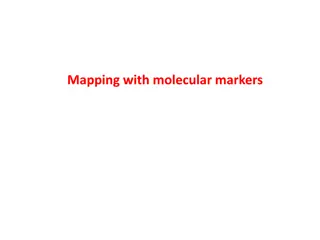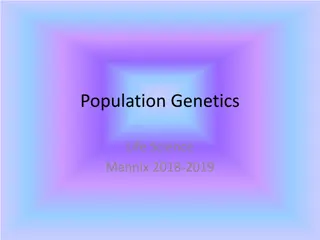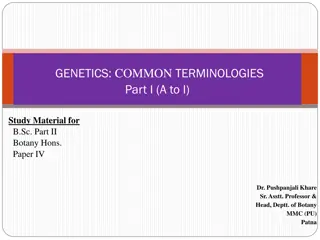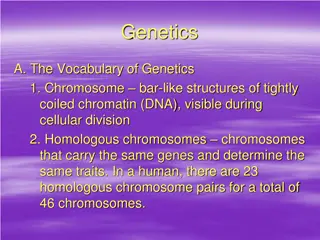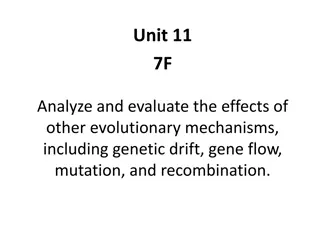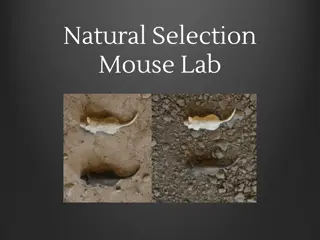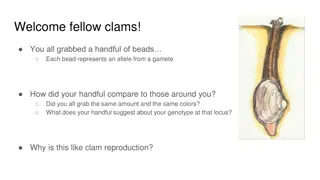Understanding Genetic Crosses and Inheritance Patterns
Discover the world of genetic crosses through gene diagrams and Punnett squares. Explore the terminology, genotype, phenotype, and the concepts of dominance and recessiveness. Learn how genes control characteristics like eye color, delve into allele combinations for flower color, and see possible ou
0 views • 15 slides
Understanding Epistasis: Types and Inferences
Epistasis is the interaction between genes where one gene's allele masks the expression of another gene. Various types of epistasis, such as dominant and recessive epistasis, can be observed, impacting the phenotypic ratios. Statistical inferences can help analyze epistatic interactions in genetic s
0 views • 35 slides
Evolutionary Insights: AP Biology Review on Population Genetics and Natural Selection
Explore themes of evolution, population genetics, and natural selection in AP Biology, delving into concepts like Hardy-Weinberg equilibrium, allele frequencies, and the impact of natural selection on introduced species. Understand how molecular and cellular events lead to emergent properties at ind
0 views • 12 slides
Exploring Evolution and Population Genetics in AP Biology
Delve into the fascinating world of evolution and population genetics with themes covering natural selection, genetic equilibrium, allele frequencies, and more. Understand how molecular and cellular events shape emergent properties at individual and population levels. Explore the impact of factors l
0 views • 12 slides
Understanding Genetic Markers in Molecular Mapping
Genetic markers play a crucial role in gene mapping within molecular biotechnology. They are fragments of DNA associated with specific genomic locations, aiding in identifying DNA sequences and analyzing genetic variation. Various types of genetic markers such as RFLP, SSR, and SNP offer insights in
1 views • 26 slides
Principles of Animal Breeding: Outbreeding and Its Classification
Outbreeding involves mating animals less closely related than the average population. It includes outcrossing, crossbreeding, grading up, and species hybridization. Outbreeding increases heterozygosity but decreases homozygosity. Heterosis, or hybrid vigor, shows the superiority of outbreds over par
0 views • 32 slides
Understanding Population Genetics and Allele Frequency Changes
Population genetics explores how allele frequencies change within populations due to factors like mutations, migration, genetic drift, nonrandom mating, and natural selection. Mutations introduce new variations, migration affects gene flow, genetic drift causes random allele loss, and examples like
1 views • 18 slides
Understanding Dominance in Genetics: The Role of Alleles and Phenotypes
Dominance in genetics refers to the interaction of alleles at the same gene locus. Complete dominance occurs when one allele masks the effect of another in a heterozygous genotype, leading to a phenotype indistinguishable from the dominant homozygote. This concept is crucial for predicting genetic o
1 views • 18 slides
Understanding Meiosis: Key Concepts in Biological Evolution
Meiosis is a crucial process in organisms, involving the formation of haploid gametes with unique allele combinations. This process ensures genetic diversity through crossing over and independent assortment, leading to variations essential for evolution. The significance of homologous chromosomes, d
1 views • 22 slides
Understanding Bikini Bottom Genetics: Predicting Traits and Probabilities
Delve into the genetics of SpongeBob's world as we explore allele combinations, phenotypes, and probabilities in predicting traits for SpongeSally, SpongeBillyBob, and other citizens of Bikini Bottom. From body shape to eye shape, uncover the genetic makeup behind Squarepants and Roundpants in this
0 views • 15 slides
Understanding Hardy-Weinberg Principle and Genetic Frequencies
Gene pool and allele frequencies play a crucial role in the Hardy-Weinberg Principle, a mathematical model predicting allele frequencies over generations. The principle outlines conditions like a large population, absence of mutations, random mating, and more. Equations such as p² + 2pq + q² = 1 h
0 views • 44 slides
Genetics Common Terminologies - Study Material for B.Sc. Botany Hons.
This study material covers common genetic terminologies from A to I, including definitions of key terms such as allele, allopolyploid, amorph, anaphase, biotype, and more. The content explains concepts like genetic inheritance, chromosome behavior, and molecular biology fundamentals relevant to the
0 views • 12 slides
Understanding Genetics: Chromosomes, Genes, and Inheritance
Genetics encompasses the study of chromosomes, genes, and inheritance patterns. Chromosomes are bar-like structures carrying DNA, with homologous pairs determining traits. Autosomes and sex chromosomes play roles in genetic makeup. Genes are hereditary units determining individual traits, with allel
0 views • 20 slides
Exploring Evolutionary Mechanisms: Genetic Drift, Gene Flow, Mutation, and Recombination
Delve into the effects of evolutionary mechanisms such as genetic drift, gene flow, mutation, and recombination in populations. Understand how changes in allele frequencies occur due to various factors like natural disasters and the bottleneck effect, impacting the gene pool and future generations.
1 views • 32 slides
Standardization Project for Clinical Pharmacogenetic Test Results
This project aimed to standardize the terms used to describe pharmacogenetic allele function and clinical phenotypes to improve clarity for clinicians and patients. Through a modified Delphi process involving expert panels, a consensus was reached on final terms and definitions for allele functional
0 views • 11 slides
Evolutionary Forces and Speciation in Iguanas: A Study from the Caribbean
After two hurricanes in 1995 carried green iguanas from Guadalupe to Anguilla, evolutionary forces are expected to act on the new iguana population. A study hypothesizes allele frequency differences between the populations, potentially leading to speciation by 2050. The morphospecies concept was use
0 views • 10 slides
Understanding Equilibria in Populations: Hardy-Weinberg Principle
Exploring the concept of equilibria in populations, focusing on Hardy-Weinberg principles and its implications. The discussion covers allele distributions, genotype frequencies, maintenance of equilibrium across generations, and scenarios where equilibrium may be violated. Key points include basic p
0 views • 58 slides
Genomic Imputation Pipeline Overview
This document outlines a genomic imputation pipeline for multiple GWAS studies using reference panels such as 1000 Genomes Phase I data. It covers steps like data matching, phasing, and imputation using tools like Beagle and Minimac. The expected output includes imputed dosages and quality measures.
0 views • 6 slides
Understanding Genetic Inheritance and Reproduction
Delve into the world of genetic inheritance and reproduction through topics such as gametes, fertilization, allele definition, genotype versus phenotype, dominant versus recessive traits, and the process of sexual reproduction. Explore how genetic information is passed on from parents to offspring,
0 views • 41 slides
Understanding Monohybrid Crosses: Incomplete Dominance and Codominance
Explore the concepts of incomplete dominance and codominance through monohybrid crosses. Learn how alleles interact to produce unique phenotypes in plants and horses. Discover the outcomes of crosses between homozygous dominant, heterozygous, and homozygous recessive individuals. Gain insights into
0 views • 7 slides
Understanding Gene Pools, Allele Frequencies, and Mutations in Population Genetics
Dive into the significance of gene pools and allele frequencies, exploring how mutations drive the emergence of new alleles. Learn about factors impacting allele frequencies like mutations, environmental pressures, genetic drift, and gene flow. Discover the types of mutations and their effects on po
0 views • 13 slides
Guide on Using BLINK C Version for Genetic Analysis
This guide provides step-by-step instructions on how to effectively use the BLINK C version for genetic analysis. It covers tasks such as preparing input files, handling phenotype and covariates data, implementing GWAS using BLINK, transforming genotype data, compressing to BLINK binary format, conv
0 views • 9 slides
Investigating Allelic Bias in Personal Genomes
This study delves into allelic bias in personal genomes, examining the influence of various factors such as sequencing datasets, removal of reads with allelic bias, and the impact on allele-specific single nucleotide variants (AS SNVs). The revised AlleleDB pipeline proposed includes steps for const
0 views • 6 slides
Natural Selection Mouse Lab: Understanding Species Changes Over Time
In this natural selection mouse lab, students investigate how species evolve over time by simulating genetic variations and environmental influences. By manipulating allele cards and event cards, students observe how different color variations of mice fare in white and brown sand environments. The l
0 views • 13 slides
Understanding Hardy-Weinberg Equilibrium in Population Genetics
The Hardy-Weinberg Equilibrium (HWE) equation provides insights into allele frequencies in a population under ideal conditions, with key requirements being no mutations, no natural selection, no gene flow, infinite or large population size, and random mating. Deviations from HWE indicate evolutionar
0 views • 5 slides
Understanding Genetic Principles Through Clam Reproduction
Explore the concept of allele inheritance using beads as gametes, relating it to clam reproduction. Discuss gamete fusion probabilities, Hardy-Weinberg Equilibrium, and frequency predictions in population genetics.
0 views • 32 slides
Understanding Whole Genome Sequencing in Public Health Training
This training activity conducted by the New York Integrated Food Safety Center of Excellence in October 2019 focuses on educating public health staff/students on the application of Whole Genome Sequencing (WGS) and whole genome multi-locus sequence typing (wgMLST) for subtyping. Through a mock case
0 views • 12 slides
Understanding Mendel's Genetic Vocabulary
Explore essential genetic terms such as Trait, Gene, Allele, Genotype, Phenotype, Dominant Allele, Recessive Allele, Heterozygous, and Homozygous in the context of Mendel's groundbreaking work on inheritance patterns. Understanding these terms is crucial for comprehending how genetic traits are pass
0 views • 14 slides




